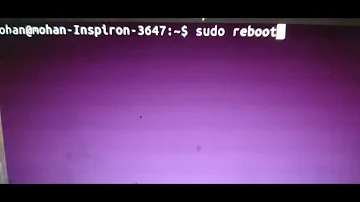Was macht sudo reboot?
What is a sudo reboot?
Various command line examples are: To reboot, use any one of the following commands: sudo reboot. sudo shutdown -r now This will perform a system shutdown in a proper way and then reboot the computer.

How do I perform a sudo reboot?
Linux system restart
To reboot the Linux system from a terminal session, sign in or “su”/”sudo” to the “root” account. Then type “ sudo reboot ” to reboot the box. Wait for some time and the Linux server will reboot itself.
How long does sudo reboot take?
By default, the system will be rebooted after 1 minute, but you can specify the exact time when you want the system to be rebooted.
How can I tell who rebooted my Linux server?
To find out who rebooted your Linux server, you need to install psacct utility, which is used to monitor the user's activity. Refer the following link to know more details about psacct. As you see above, the user called "sk" has executed 'reboot' command from 'pts0' on Monday April 2, at 15:05 local time.
Do I need sudo to reboot?
Now that you have the terminal open, you can now utilize the reboot command on Linux to restart the system. This command is simply used by using “ sudo ” followed by “ reboot “. Please note, if you are using the root user, you do not need to use “ sudo ” in front of “ reboot “. 3.
What exactly does sudo do?
Sudo stands for either "substitute user do" or "super user do" and it allows you to temporarily elevate your current user account to have root privileges. This is different from “su” which is not temporary.
Is reboot and restart same?
Boot and reboot mean almost the same. Restart/Start: They mean almost the same. Unlike a reset which changes something, a restart means to turn something on, possibly without changing settings.
What is the difference between reboot and restart?
Restart starts the firewall and IPS services without rebooting the underlying operating system. Reboot includes the OS as well as all of the services.
How can I check reboot history?
View Shutdown and Restart Log from Event Viewer
Open Event Viewer (press Win + R[Run] and type eventvwr). In the left pane, open “Windows Logs >> System.” In the middle pane, you will get a list of events that occurred while Windows was running. You can sort the event log with the Event ID.
How do I check my server reboot history?
1. Use the Event Viewer
- Press Win + R to open a Run dialog.
- Type eventvwr in the text field of the dialog box and hit Enter. …
- Expand the Windows Logs section from the left pane and select System.
- Choose Filter current log from the left pane.
- Now, type the event ID that you wish to check under Includes/Excludes Event IDs.
What does sudo actually do?
Sudo stands for either "substitute user do" or "super user do" and it allows you to temporarily elevate your current user account to have root privileges. This is different from “su” which is not temporary.
What is the purpose of sudo?
Sudo (superuser do) is a utility for UNIX- and Linux-based systems that provides an efficient way to give specific users permission to use specific system commands at the root (most powerful) level of the system. Sudo also logs all commands and arguments.
What happens when you run sudo?
The sudo command allows you to run programs with the security privileges of another user (by default, as the superuser). It prompts you for your personal password and confirms your request to execute a command by checking a file, called sudoers , which the system administrator configures.
What sudo stands for?
substitute user do
sudo , which is an acronym for superuser do or substitute user do, is a command that runs an elevated prompt without a need to change your identity. Depending on your settings in the /etc/sudoers file, you can issue single commands as root or as another user.
What exactly is a reboot?
noun. re·boot ˈrē-ˌbüt. plural reboots. : the act or an instance of shutting down and restarting something (such as a computer or program) In a few cases, errors cause a headlong exit to DOS or the software ceases to operate, requiring a reboot.
Does reboot mean refresh?
To reboot is to reload the operating system of a computer: to start it up again. Booting is starting a computer's operating system, so rebooting is to start it for a second or third time. Rebooting is usually necessary after a computer crashes, meaning it stops working because of a malfunction.
How can I tell when a Linux system was last rebooted?
Last Command To Check The Last Reboot Time
The last command searches back through the /var/log/wtmp file (or the file designated by the -f option) and displays a list of all users logged in (and out) since that file was created.
Does reboot wipe all data?
To perform a soft reset, you power off your phone and turn it back on. Restarting your phone closes all the processes and apps running on your phone and loads all the system files from scratch. A soft reset does not come with the risk of losing your data.
How to check reboot history in Linux?
Use who command to find last system reboot time/date
The last command searches back through the file /var/log/wtmp and displays a list of all users logged in (and out) since that file was created. The pseudo user reboot logs in each time the system is rebooted.
How do I check my server activity log?
Checking Windows Event Logs
- Press ⊞ Win + R on the M-Files server computer. …
- In the Open text field, type in eventvwr and click OK. …
- Expand the Windows Logs node.
- Select the Application node. …
- Click Filter Current Log… on the Actions pane in the Application section to list only the entries that are related to M-Files.
What does sudo stand for?
substitute user do
sudo , which is an acronym for superuser do or substitute user do, is a command that runs an elevated prompt without a need to change your identity. Depending on your settings in the /etc/sudoers file, you can issue single commands as root or as another user.
Why is it called sudo?
It originally stood for "superuser do", as that was all it did, and it is its most common usage; however, the official Sudo project page lists it as "su 'do' ".
What happens if you run sudo as root?
[ You might also enjoy: Linux command line basics: sudo ]
Working as root means that you have the power to: Remove any or all files. Change the permissions of any or all files. Change the runlevel of the system.
Where is sudo used?
The sudo command allows you to run programs with the security privileges of another user (by default, as the superuser). It prompts you for your personal password and confirms your request to execute a command by checking a file, called sudoers , which the system administrator configures.
What is sudo vs sudo?
A comparison of su and sudo
Some key differences between su and sudo include: su allows a user to switch to another user account and gain all of its privileges, while sudo allows a user to execute a specific command with the privileges of another user.


